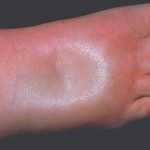 Excess retention of fluid in the body; may be caused by cardiac, renal, or hepatic failure or by starvation (famine oedema).
Excess retention of fluid in the body; may be caused by cardiac, renal, or hepatic failure or by starvation (famine oedema).
The presence of abnormally large amounts of fluid in the intercellular tissue spaces of the body.
Swelling of tissue due to an accumulation of fluids, often caused by kidney or heart failure.
The swelling of part of the body caused by accumulation of fluid in the intercellular tissue spaces.
An abnormal accumulation of fluid beneath the skin, or in one or more of the cavities of the body.
Unusual buildup of fluid in bodily tissues can manifest as localized swelling (as seen in injury-related edema) or widespread occurrence (as observed in cases of heart failure).
Approximately three-fifths of body weight is comprised of water, and this fluid is in a constant exchange between blood and tissues. The pressure generated by the heart’s pumping action pushes water out of the capillaries (tiny blood vessels) and into the surrounding tissues. In a reverse process that relies on the water-attracting capability of proteins in the blood, water is reabsorbed from the tissues into the capillaries and lymphatic vessels. Typically, these two mechanisms maintain equilibrium, thereby maintaining a relatively consistent distribution of water between the blood and tissues.
The kidneys, in conjunction with hormones like ADH, manage the overall volume of fluid within the body. Any surplus is eliminated from the body through urine.
Multiple disorders have the potential to interrupt these mechanisms. Heart failure results in vein congestion, generating a reverse pressure within the capillaries. This counteracts the osmotic pressure within the capillaries, leading to an excessive influx of fluid into the tissues. Additionally, a tumor pressing against veins can generate backward pressure, inducing swelling (edema) in the region served by the obstructed vein.
Nephrotic syndrome involves an anomalous leakage of protein from the bloodstream, which diminishes osmotic pressure and obstructs the adequate movement of fluid from the tissues into the blood. In cases of kidney failure, the inability to expel salt from the body results in its buildup within the tissues, thereby drawing water towards it.
Additional conditions that can induce edema encompass liver cirrhosis, wherein blood accumulates within the liver’s veins, causing a reduction in blood protein (and consequently osmotic pressure), along with salt retention. An insufficiency of dietary protein, as observed in individuals with alcoholism, can similarly decrease osmotic pressure.
Injury or inflammation can trigger edema by prompting capillaries to become permeable and leak fluid. The obstruction of lymphatic vessels can lead to the development of lymphedema.
Edema can also be induced by specific medications, like corticosteroids, which influence the kidneys and lead to the retention of salt.
Signs of widespread edema, like puffiness near the lower spine (in individuals confined to bed) or swelling in the ankles, manifest when bodily fluids exceed a 15 percent increase. In severe instances, fluid collects within significant body cavities, such as the peritoneal cavity in the abdomen (ascites) or the pleural cavity in the lungs (pleural effusion). In pulmonary edema, the lung’s air sacs become saturated with fluid, leading to breathlessness.
Addressing the root cause of the edema is crucial. If rectifying the cause isn’t feasible, symptoms can be alleviated by eliminating the surplus fluid. Boosting kidney-produced urine output can be achieved through dietary salt reduction and the utilization of diuretic medications.
